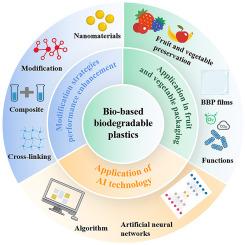Advancing bio-based biodegradable plastics for fruit and vegetable packaging: Multi-scale modifications for performance enhancement
IF 15.4
1区 农林科学
Q1 FOOD SCIENCE & TECHNOLOGY
引用次数: 0
Abstract
Background
Postharvest packaging is crucial for maintaining the quality of fruits and vegetables, reducing spoilage, and extending shelf life. As a sustainable alternative to fossil-based plastics, bio-based biodegradable plastics (BBPs) have attracted significant attention due to their degradability and environmental friendliness. However, their limited mechanical strength, barrier properties, and functionality currently hinder widespread use in fruit and vegetable preservation. Addressing these limitations through material modification is key to advancing their commercial application.
Scope and approach
This review focuses on BBPs and covers the following areas: (1) an overview of BBPs; (2) multi-scale modification strategies of BBPs and their impact on performance enhancement; (3) applications of BBPs in fruit and vegetable packaging; and (4) emerging applications of artificial intelligence technologies in the development of BBP packaging.
Key findings and conclusions
Multi-scale modifications significantly enhance the mechanical and barrier properties of BBPs, while also imparting antimicrobial and antioxidant functions necessary for effective fruit and vegetable preservation. In addition, the integration of artificial intelligence provides novel approaches for the modification of BBPs. This review provides practical insights to promote the optimization and broader adoption of BBP packaging in the fruit and vegetable industry.

用于果蔬包装的先进生物基可生物降解塑料:提高性能的多尺度改性
摘后包装对于保持水果和蔬菜的质量、减少腐败和延长保质期至关重要。生物基生物降解塑料(BBPs)作为化石基塑料的可持续替代品,因其可降解性和环境友好性而受到广泛关注。然而,它们有限的机械强度,屏障性能和功能目前阻碍了水果和蔬菜保存的广泛应用。通过材料改性解决这些限制是推进其商业应用的关键。范围和方法本综述以bbp为重点,涵盖以下领域:(1)bbp概述;(2) bbp的多尺度修正策略及其对性能提升的影响;(3) BBPs在果蔬包装中的应用;(4)人工智能技术在BBP包装发展中的新兴应用。多尺度修饰可显著提高BBPs的机械和屏障性能,同时赋予其有效保存水果和蔬菜所需的抗菌和抗氧化功能。此外,人工智能的集成为bbp的改造提供了新的途径。这篇综述提供了实用的见解,以促进优化和更广泛的采用BBP包装在水果和蔬菜行业。
本文章由计算机程序翻译,如有差异,请以英文原文为准。
求助全文
约1分钟内获得全文
求助全文
来源期刊

Trends in Food Science & Technology
工程技术-食品科技
CiteScore
32.50
自引率
2.60%
发文量
322
审稿时长
37 days
期刊介绍:
Trends in Food Science & Technology is a prestigious international journal that specializes in peer-reviewed articles covering the latest advancements in technology, food science, and human nutrition. It serves as a bridge between specialized primary journals and general trade magazines, providing readable and scientifically rigorous reviews and commentaries on current research developments and their potential applications in the food industry.
Unlike traditional journals, Trends in Food Science & Technology does not publish original research papers. Instead, it focuses on critical and comprehensive reviews to offer valuable insights for professionals in the field. By bringing together cutting-edge research and industry applications, this journal plays a vital role in disseminating knowledge and facilitating advancements in the food science and technology sector.
 求助内容:
求助内容: 应助结果提醒方式:
应助结果提醒方式:


